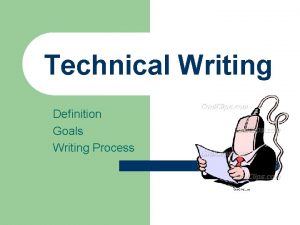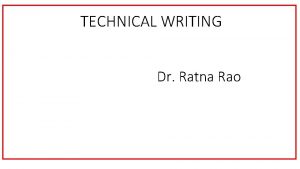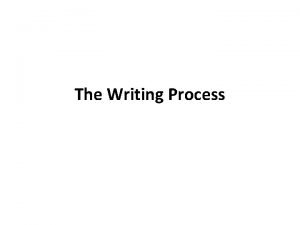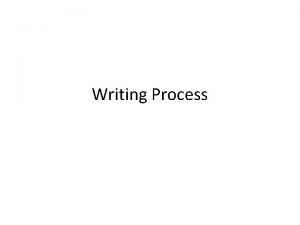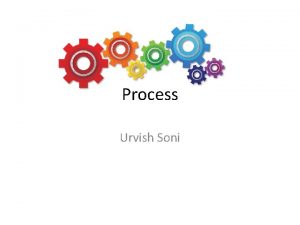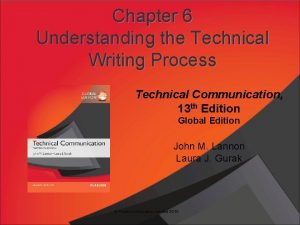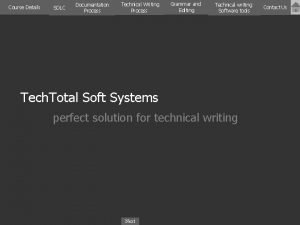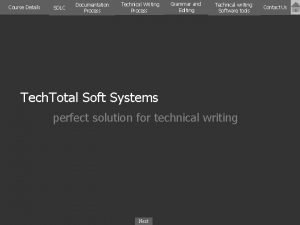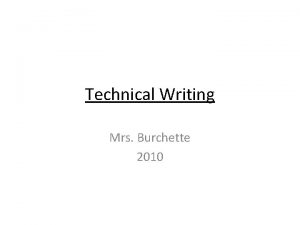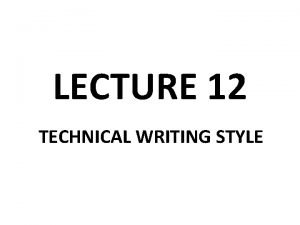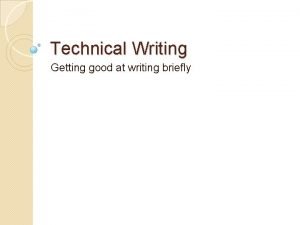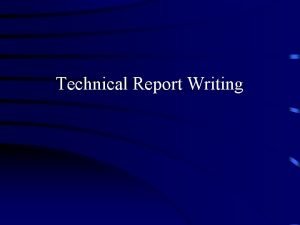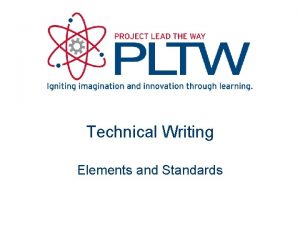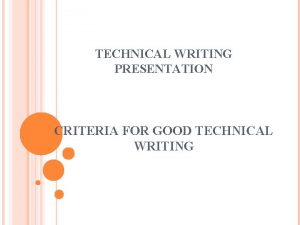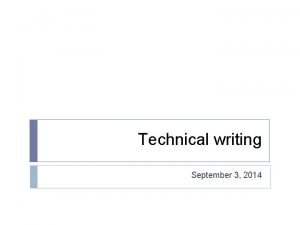UNIT 2 THE TECHNICAL WRITING PROCESS Technical Writing





















- Slides: 21

UNIT 2: THE TECHNICAL WRITING PROCESS Technical Writing EE 3013 – Lecture 3 1

The Technical Writing Process • Principles of Technical Writing • Process of Effective Writing • Technical Style • Qualities of Technical Style • Tips for Improving your Technical Writing Style Technical Writing EE 3013 – Lecture 3 2

1. Principles of Technical Writing • Know the audience you are addressing • Decide your purpose before writing • Start by telling your reader what you are going to tell them • Write simply and concisely • Avoid jargon as much as possible • Never use a word without being sure of its meaning Technical Writing EE 3013 – Lecture 3 3

1. Principles of Technical Writing • Make your material attractive to look at and to read • Use graphics whenever they help you to convey your meaning • Review, check, and edit your own work carefully by asking yourself the following questions: 1) Would I want to read what I have written? 2) What reactions can I expect from my readers? 3) Is my main message clear? 4) Have I answered the who, what, why, where and how that my readers might ask? Technical Writing EE 3013 – Lecture 3 4

2. Process of Effective Writing 2. 1: Define the Purpose: • Decide why you are writing this communication • Prepare a ‘Thesis Statement’ which in one sentence states your main message • Post it in your workspace • Decide to whom you are addressing the message and assess their needs by asking yourself: 1) What do they already know? 2) What do they need to know from me? Technical Writing EE 3013 – Lecture 3 5

2. Process of Effective Writing 2. 2: Investigate: • Determine all the possible sources of information • Obtain all of the facts relevant to your purpose • Analyse your information • Sift through your analysis and discard any information that does not address your purpose • Prepare rough tables, graphs, and other analyses that aid in the development of your purpose Technical Writing EE 3013 – Lecture 3 6

2. Process of Effective Writing 2. 3: Plan: • Re-gather all of the relevant facts and organize them in a logical manner for presentation es gg Su n io st ge g Su - Chronological Approach - Logical Order - Scientific Method. . . tio n • Establish an appropriate subject-development to portray your main message: • Use the Big Paper Planning approach if you have trouble with this stage Technical Writing EE 3013 – Lecture 3 7

2. Process of Effective Writing 1: Generate 2: 3: 4: 5: Group Sequence Develop Fill in Missing Ideas Links Ideas Groups Sub-groups Links Big Paper Planning: Step 6: Idea 1 Idea 2 Idea 3 Idea 9 Idea 10 Idea 6 Idea 4 Idea 5 Idea 7 Idea 8 Idea 3 Idea 9 Idea 6 Idea 1 Idea 7 Idea 10 Idea 8 Idea 4 Idea 5 Idea 2 Idea 3 Idea 9 Idea 5 Idea 2 Idea 10 Idea 8 Idea 4 Idea 6 Idea 1 Idea 7 Link Idea 3 Idea 9 Idea 2 Idea 5 Missing Idea 4 Link Idea 8 Idea 10 New Idea 1 Idea 6 Idea 7 • On 1 very large piece of paper (16” x 14”) Technical Writing EE 3013 – Lecture 3 8

2. Process of Effective Writing Big Paper Planning: • idea brainstorm On 1 very large piece of paper (16” x 14”) • Chunk your ideas into groups • Sequence the groups • Sub-divide the groups and sequence the sub-groups • Check for adequate links • Fill in missing connections with additional information Technical Writing EE 3013 – Lecture 3 9

2. Process of Effective Writing 2. 4: Write: • Write the first draft using simple words and short sentences • Remember your intended audience • Use appropriate sectioning based upon the document type • Integrate tables, graphs, and other illustrations into the text Technical Writing EE 3013 – Lecture 3 10

2. Process of Effective Writing 2. 4: Write: • Write as continuously as possible in comfortable surroundings Technical Writing EE 3013 – Lecture 3 11

2. Process of Effective Writing 2. 5: Delay: • Allow the draft to sit as long as possible without revision Technical Writing EE 3013 – Lecture 3 12

2. Process of Effective Writing 2. 5: Revise: • Read the text aloud - Does it make sense? • Ensure that the text is clear, concise, complete correct, and reliable • Ensure that the main message has been communicated • Ensure that all credits have been given to sources • Obtain and use feedback from external sources Technical Writing EE 3013 – Lecture 3 13

3. Technical Style • Style is defined as the way a communicator: - puts words together in sentences - arranges those sentences into paragraphs - groups paragraphs into sections to ensure that the communication is conveyed in the intended manner Technical Writing EE 3013 – Lecture 3 14

3. Technical Style • Technical Writing Style is characterized by: - a calm, restrained tone, regardless of formality - use of active voice where possible - integrated use of illustrations, graphs, charts, and tables - use of well-defined abbreviations and symbols Technical Writing EE 3013 – Lecture 3 15

3. Technical Style • Technical Writing Style is characterized by: - a definite functional purpose to communicate information Technical Writing EE 3013 – Lecture 3 16

3. Technical Style • Technical Writing Style is characterized by: • Style reflects both intrinsic and extrinsic qualities of the communication: Intrinsic Qualities Extrinsic Qualities - Objective - Clear - Impersonal - Concise - Restrained - Focused - Honest - Consequential - Genderneutral Technical Writing EE 3013 – Lecture 3 17

4. Qualities of Technical Style 4. 1. Being Clear: • Coherent - Establish logical connections between your ideas • Coordinated - Arrange your ideas in a logical order • Consistent - Present your ideas in the same general format • Correct - Check your spelling, punctuation and grammar Technical Writing EE 3013 – Lecture 3 18

4. Qualities of Technical Style 4. 2. Being Concise: • Choose your words carefully so that you can get the most out of them. Make sure that they are: - Short - Specific - Necessary Technical Writing EE 3013 – Lecture 3 19

4. Qualities of Technical Style 4. 3. Being Focused: • State your problem definition and stick to describing and solving that problem Post it! Suggestion Can time-frequency transforms be used to track trends with fatigue in dynamic muscle contractions? Technical Writing EE 3013 – Lecture 3 20

4. Qualities of Technical Style 4. 4. Being Consequential: • Make sure that the content in your document is complete, reliable, and aimed at an appropriate level Technical Writing EE 3013 – Lecture 3 21
 Teknikal na pagsulat
Teknikal na pagsulat Technical writing vs academic writing
Technical writing vs academic writing Unit 6 review questions
Unit 6 review questions Unit process and unit operation
Unit process and unit operation What is unit operation and unit process
What is unit operation and unit process Hình ảnh bộ gõ cơ thể búng tay
Hình ảnh bộ gõ cơ thể búng tay Bổ thể
Bổ thể Tỉ lệ cơ thể trẻ em
Tỉ lệ cơ thể trẻ em Chó sói
Chó sói Tư thế worm breton là gì
Tư thế worm breton là gì Hát lên người ơi alleluia
Hát lên người ơi alleluia Môn thể thao bắt đầu bằng chữ đua
Môn thể thao bắt đầu bằng chữ đua Thế nào là hệ số cao nhất
Thế nào là hệ số cao nhất Các châu lục và đại dương trên thế giới
Các châu lục và đại dương trên thế giới Công thức tính thế năng
Công thức tính thế năng Trời xanh đây là của chúng ta thể thơ
Trời xanh đây là của chúng ta thể thơ Cách giải mật thư tọa độ
Cách giải mật thư tọa độ Phép trừ bù
Phép trừ bù Phản ứng thế ankan
Phản ứng thế ankan Các châu lục và đại dương trên thế giới
Các châu lục và đại dương trên thế giới Thể thơ truyền thống
Thể thơ truyền thống
